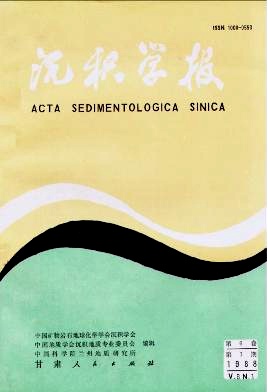Zhou Zili. AUTHIGENIC ORIGIN AND FORMATION TEMPERATURE OF STEP-LIKE GARNET FROM LOWER TERTIARY SANDSTONE,SHENGLI OIL FIELD,SHANDONG[J]. Acta Sedimentologica Sinica, 1988, 6(1): 13-20.
| Citation:
|
Zhou Zili. AUTHIGENIC ORIGIN AND FORMATION TEMPERATURE OF STEP-LIKE GARNET FROM LOWER TERTIARY SANDSTONE,SHENGLI OIL FIELD,SHANDONG[J]. Acta Sedimentologica Sinica, 1988, 6(1): 13-20.
|
AUTHIGENIC ORIGIN AND FORMATION TEMPERATURE OF STEP-LIKE GARNET FROM LOWER TERTIARY SANDSTONE,SHENGLI OIL FIELD,SHANDONG
- Received Date: 1986-01-18
- Publish Date:
1988-03-10
-
Abstract
Step-like garnets, i.e. garnets with faceted surface, occur in heavy from the reservoir rocks of Lower Tertiary sandstones. Many people that it resulted from dissolution or chemical etching,but many evidences this is not true in the study area. The writer suggests that it is anmineral and can be used as an excellent mineral geothermo meter. Studies by means of SEM show that the surface microtexture of the surface microtexture of the step-like garnets consisted of euhedral crystal faces are very regular and well defined,no evidence of dissolution or chemical etching can be found. The chemical compositions are analyzed by energy dispesive analyser,which indicates that all of the authigenic garnets have certain chemical compositions similar to those of almandine. The authigenic garnet is an excellent mineral geothermometer, its distribution is closely related to its burial depth and the geothermal gradient. It is found in Oligocene sandstones at depth more than 2100m, the amount of the step-like garnets increases with the increase the shape tends tomore complex and more variable. The studied area was a downfauited basin with continuous subsidence during Cenozoic Period and favours to study the burial diagenetic minerals.In comparison of the calculated temperature correspoding to depths of various burial diagenetic minerals with the measured temperature of these minerals in studied area, it is suggested that the calculated temperature is approximate or equal to the temper-ature limit of these mineral formation.According to the calculation results of the data f rom 13 wells, it is demonstrated that the step-like garnets are formed at 92 1 5 C,which approximates to the threshold temperature (93`i})of the oil generation in Dongying Basin. It is important for the evolution of source rocks and reserviorrocks in a new exploration area. Detailed investigations of more deeply-buried sediments have shown that several kinds of burial diagenesis involving the almandine formation or precipitaion can contempraneously occur, such as the conversion of the smectite to illite in mudstone and the dissolution of the feldspar in sandstone.The coversion of smectite to illite involves the release of a considerable number of components including Fe, Mg,Si,all of which are required for the almandine formation.
-
References
|
[1]
|
Pystawalov, L. B.,1956, Secondary change of sedimentary rocks and their significance. Tr. GeoI, Akad. Nauk SSSR, I9-22. |
|
[2]
|
Rahmani, R.A, 1973, Grain surface etching feature of some heavy minerals.J. Sediment. Petrol, V. 43, 882-888. |
|
[3]
|
Morton, A.C.,1984, Stability of detrital heavy minerals in Tertiary sand-stops from the North Sea Basin. Clay Minerals, V.19, 287-308. |
|
[4]
|
Franks, S, G.,I984, Relationships among carbon dioxide, pore-fluid the-mistry, and secondary porsity, Texas Gulf Coast(abs.).Bull. Am. Ass-oc. Pet. Geol. V .68, 478. |
|
[5]
|
Hazeldine, R.S.,1984, Quartz diagenesis and convective fluid movement, Beatrice Oilfield, UK. North ,'Sea. Clay Minerals, V. 19, 391-402. |
|
[6]
|
Hoffman, J. and Hower, J.,1979, Clay mineral assemblies as low grade metamorphic geothermometerss Application to the thrustfaulted disturbed Belt of MontanaU.S.A.,SEPM, Special Publication, V. 26,35-79. |
|
[7]
|
Hower, J.,Eslinger, E, V.,Hower, M. E. and Perry, E. A.,1976, Me-chanism of argillaceous sediments, Mineralogical and chemical evidence.Bull. Geol. Soc, Amer. 87, 725-737. |
|
[8]
|
Surdam, R, C, 1984,Mineral oxidants and porosity enhancement. Bull. Am-er. Assoc. Pet. Geol. V.68, p. 523. |
-
-
Proportional views

-






 DownLoad:
DownLoad: